Opinion & Analysis
Does the Golf Ball Go Too Far?
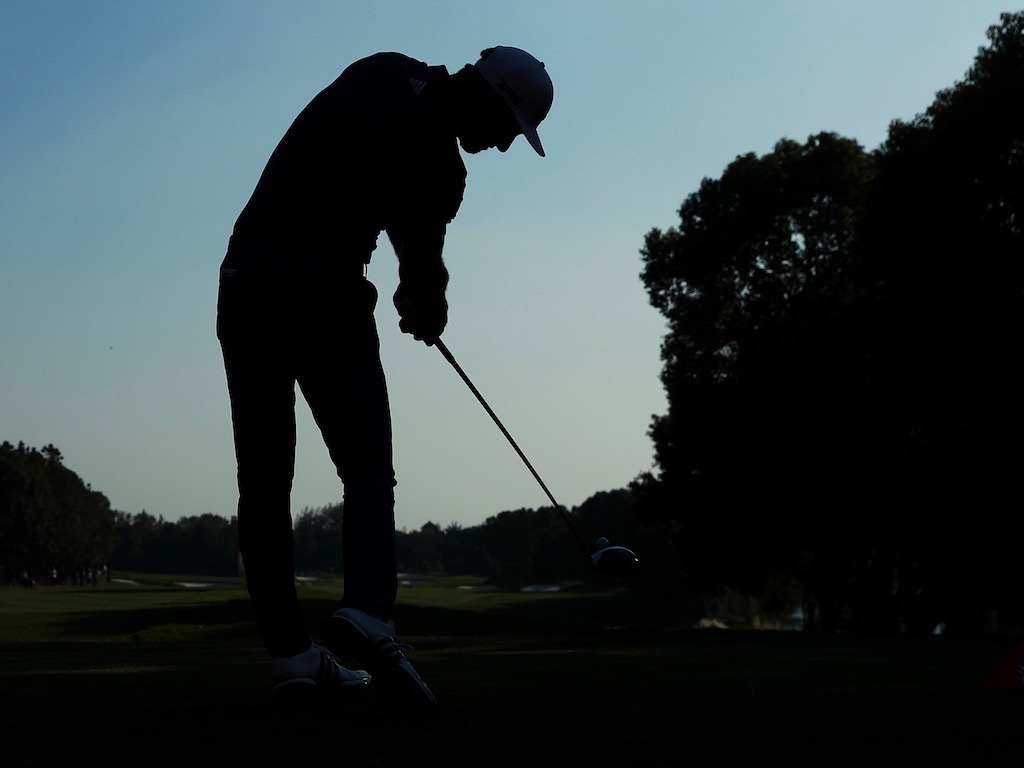
Recently we have heard everyone discussing whether or not PGA Tour players hit the golf ball too far. Everyone from Tiger Woods to Brad Faxon, Brandel Chamblee, Mike Davis, and Wally Uihlein have weighed in with their thoughts. I myself have struggled with what side of the fence I should be on, so I wanted to learn more about it before I made a judgement.
Because I am a golf nerd, I decided to do a little digging.
My first question in all of this is, what is too far? How do we judge that the golf ball or distance has reached a point where it is diminishing the product for our viewing pleasure? How do we know if technology and distance have effected the integrity of the game? Too far is a statement of relativity. One-hundred years ago, it could have taken you 12 hours to travel 200 miles. Now you can fly Los Angeles to Sydney in that same amount of time.
When Harry Vardon was winning championships early in his career, he and every other competitor exclusively used the gutta percha golf ball with his name on it, “The Vardon Flyer.” The gutta percha was invented in 1848 and used until a new ball came into play in the early 1900’s. This new ball was the Haskell Rubber ball invented by Coburn Haskell and Betrum Work. It was the first rubber ball that was a complete game changer. Despite is obvious performance enhancements and distance gained, however, many of the top players were slow to begin to play the new ball. In fact, it took Harry Vardon almost 10 years to make the switch. I can imagine they were having the same conversations back then that we are having today.
There are tons of examples of this throughout golf history, and although there have been limitations on technology there has never been a roll back in the golf ball. The ball has always won out. So I ask myself and you why now are we claiming that the ball is going too far? I decided to compare scoring average on the PGA Tour to driving distance and golf course length. Below in the graphs you will see what I found.
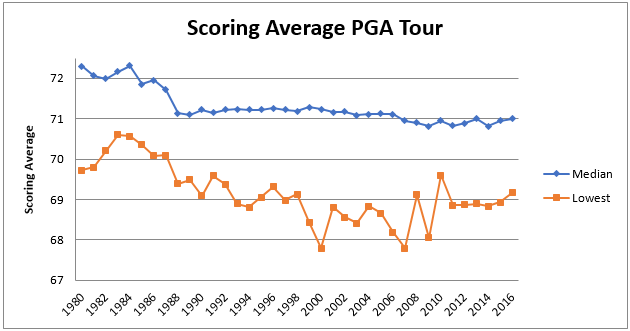
First, I must say it is very difficult to find accurate data on driving distance and scoring average before 1980. From 1980 to present time, this information has been tracked by the PGA Tour, so I decided to only look at the past 37 years for an example. Since 1980, the PGA Tour median scoring average has gone from 72.3 to 70.995 in 2016. That is a difference of 1.305 shots or a change of 1.8 percent over 37 years. The lowest scoring average on the PGA Tour has gone from 69.73 to 69.17. That is a difference of o.56 strokes or an 0.8 percent of change. So yes, scoring average has gotten better. Is this because the golf ball is going farther?
Let’s now look at driving distance on the PGA Tour since 1980 in the chart below.
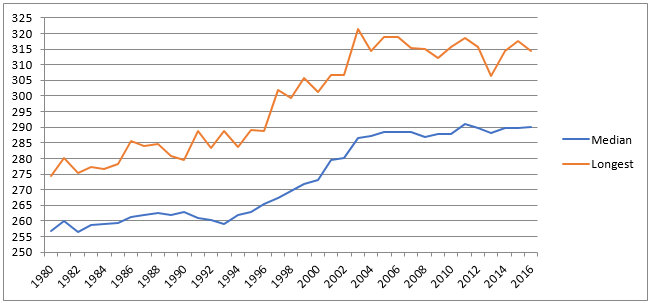
In 1980, the median driving distance on the PGA Tour was 256.7 yards. In 2016, it was 290.1 yards. That is a gain of 33.4 yards over 37 years, or about 1 yard per year. This is a percentage change of 13 percent. The longest hitter in 1980 averaged 274.3 yards. In 2016, the longest hitter averaged 314.5 yards, an improvement of 40.2 yards. That’s a percentage change of 14.6 percent. PGA Tour players in 2016 hit it a lot farther than they did in 1980, yet scoring averages haven’t changed much. Is this because golf course length has kept up with distance gained?
Finding course length information since 1980 was difficult. I decided to only look at the majors championships as examples, where data is more plentiful. From here, I made the decision to only use the U.S. Open and PGA Championship. Unlike the Masters, they are played on a different course every year. As for The Open Championship, it’s generally a different kind of golf where distance and strategy can hinge on the elements. I felt as though this was the best representation for all courses on the PGA Tour. In the chart below, you will find the average course length of the U.S. Open and PGA Championship from 1980-2016.
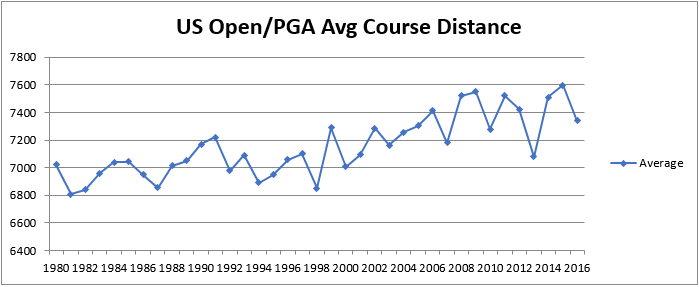
As you can see, golf courses have absolutely gotten longer. For this chart, I will compare the shortest average length (1981) to the longest average course length (2015). I am doing this because of the smaller data sample size and I believe this would more correctly illustrate the average of all PGA Tour courses. From 1981 to 2015 the golf course length increased by 791 yards (6807 yards to 7598 yards). That’s an increase of 11.6 percent.
For review, we have seen scoring average decrease by 1.8 percent, driving distance increase by 13 percent and course length increase by 11.6 percent. The difficult part about looking at this much data is always trying to interpret it. How is the data helpful, and what story does it tell?
Let’s revisit the driving distance chart one more time with some timeline reference points to paint the picture in a clearer way. These are some of the biggest technological advances in golf since 1980, and they tell a fantastic story of why we saw certain leaps in distance over a short amount of time.
- From 1991 to 2000, the decade of the introduction of bigger metal woods from the 190-cubic-centimeter Big Bertha to the 300-cubic-centimeter Titleist 975D, there was median distance increase of 4.7 percent (12.3 yards).
- Just in the year from 2000–2001, which saw the solid-core Titleist Pro V1 introduced in October of 2000, there was a median distance increase in 2.3 percent (6.3 yards).
- From 2002–2003 (TaylorMade introduced the adjustable-weight R7 driver on Tour in 2004), there was a median distance increase of 2.4 percent (6.6 yards).
In just 4 short years (2000–2003), the median distance on the PGA Tour increased by a whopping 4.9 percent (13.4 yards). Of course, there was a necessary and actionable reaction to this by the USGA when it limited the driver to 460 cubic centimeters following the 2003 season and finalized the COR limit. Since 2003, we have only seen a change in median distance of 1.2 percent, or 3.5 yards. I believe this gain in distance can be explained by better fitting and the presence of launch monitors like TrackMan on tour. There has also been more adjustability added to drivers and several upgrades in shaft technology.
What I don’t understand when looking at this data is why are we just now saying the golf ball is going too far. It seems to me we are 15 years too late in noticing.
- LIKE215
- LEGIT25
- WOW12
- LOL8
- IDHT2
- FLOP5
- OB2
- SHANK20
19th Hole
Vincenzi’s 2024 Wells Fargo Championship betting preview: Tommy Fleetwood ready to finally land maiden PGA Tour title

The PGA Tour season ramps back up this week for another “signature event,” as golf fans look forward to the year’s second major championship next week.
After two weaker-field events in the Zurich Classic and the CJ Cup Byron Nelson, most of the best players in the world will head to historic Quail Hollow for one of the best non-major tournaments of the year.
Last season, Wyndham Clark won the event by four shots.
Quail Hollow is a par-71 measuring 7,521 yards that features Bermudagrass greens. The tree-lined, parkland style course can play quite difficult and features one of the most difficult three-hole stretches in golf known as “The Green Mile,” which makes up holes 16-18: two mammoth par 4s and a 221-yard par 3. All three holes have an average score over par, and water is in play in each of the last five holes on the course.
The field is excellent this week with 68 golfers teeing it up without a cut. All of the golfers who’ve qualified are set to tee it up, with the exception of Scottie Scheffler, who is expecting the birth of his first child.
Past Winners at Quail Hollow
- 2023: Wyndham Clark (-19)
- 2022: Max Homa (-8)
- 2021: Rory McIlroy (-10)
- 2019: Max Homa (-15)
- 2018: Jason Day (-12)
- 2017: Justin Thomas (-8) (PGA Championship)
- 2016: James Hahn (-9)
- 2015: Rory McIlroy (-21)
Key Stats For Quail Hollow
Strokes Gained: Approach
Strokes gained: Approach will be extremely important this week as second shots at Quail Hollow can be very difficult.
Total SG: Approach Over Past 24 Rounds
- Akshay Bhatia (+1.16)
- Tom Hoge (+1.12)
- Corey Conners (+1.01)
- Shane Lowry (+0.93)
- Austin Eckroat (+0.82)
Strokes Gained: Off the Tee
Quail Hollow is a long course on which it is important to play from the fairway. Both distance and accuracy are important, as shorter tee shots will result in approach shots from 200 or more yards. With most of the holes heavily tree lined, errant drives will create some real trouble for the players.
Strokes Gained: Off the Tee Past 24 Rounds:
- Ludvig Aberg (+0.73)
- Rory McIlroy (+0.69)
- Xander Schauffele (+0.62)
- Viktor Hovland (+0.58)
- Chris Kirk (+0.52)
Proximity: 175-200
The 175-200 range is key at Quail Hollow. Players who can hit their long irons well will rise to the top of the leaderboard.
Proximity: 175-200+ over past 24 rounds:
- Cameron Young (28’2″)
- Akshay Bhatia (29’6″)
- Ludvig Aberg (+30’6″)
- Sam Burns (+30’6″)
- Collin Morikawa (+30’9″)
SG: Total on Tom Fazio Designs
Players who thrive on Tom Fazio designs get a bump for me at Quail Hollow this week.
SG: Total on Tom Fazio Designs over past 36 rounds:
- Patrick Cantlay (+2.10)
- Rory McIlroy (+1.95)
- Tommy Fleetwood (+1.68)
- Austin Eckroat (+1.60)
- Will Zalatoris (+1.57)
Strokes Gained: Putting (Bermudagrass)
Strokes Gained: Putting has historically graded out as the most important statistic at Quail Hollow. While it isn’t always predictable, I do want to have it in the model to bump up golfers who prefer to putt on Bermudagrass.
Strokes Gained: Putting (Bermudagrass) Over Past 24 Rounds:
- Taylor Moore (+0.82)
- Nick Dunlap (+.76)
- Wyndham Clark (+.69)
- Emiliano Grillo (+.64)
- Cam Davis (+.61)
Course History
This stat will incorporate players that have played well in the past at Quail Hollow.
Course History over past 36 rounds (per round):
- Rory McIlroy (+2.50)
- Justin Thomas (+1.96)
- Jason Day (+1.92)
- Rickie Fowler (+1.83)
- Viktor Hovland (+1.78)
Wells Fargo Championship Model Rankings
Below, I’ve compiled overall model rankings using a combination of the five key statistical categories previously discussed — SG: Approach (27%), SG: Off the Tee (23%), SG: Total on Fazio designs (12%), Proximity: 175-200 (12%), SG: Putting Bermuda grass (12%), and Course History (14%).
- Wyndham Clark
- Rory McIlroy
- Xander Schauffele
- Shane Lowry
- Hideki Matsuyama
- Viktor Hovland
- Cameron Young
- Austin Eckroat
- Byeong Hun An
- Justin Thomas
2024 Wells Fargo Championship Picks
Tommy Fleetwood +2500 (DraftKings)
I know many out there have Tommy fatigue when it comes to betting, which is completely understandable given his lack of ability to win on the PGA Tour thus far in his career. However, history has shown us that players with Fleetwood’s talent eventually break though, and I believe for Tommy, it’s just a matter of time.
Fleetwood has been excellent on Tom Fazio designs. Over his past 36 rounds, he ranks 3rd in the field in Strokes Gained: Total on Fazio tracks. He’s also been incredibly reliable off the tee this season. He’s gained strokes in the category in eight of his past nine starts, including at The Masters, the PLAYERS and the three “signature events” of the season. Tommy is a golfer built for tougher courses and can grind it out in difficult conditions.
Last year, Fleetwood was the first-round leader at this event, firing a Thursday 65. He finished the event in a tie for 5th place.
For those worried about Fleetwood’s disappointing start his last time out at Harbour Town, he’s bounced back nicely after plenty of poor outings this season. His T7 at the Valero Texas Open was after a MC and T35 in his prior two starts and his win at the Dubai Invitational came after a T47 at the Sentry.
I expect Tommy to bounce back this week and contend at Quail Hollow.
Justin Thomas +3000 (DraftKings)
It’s been a rough couple of years for Justin Thomas, but I don’t believe things are quite as bad as they seem for JT. He got caught in the bad side of the draw at Augusta for last month’s Masters and has gained strokes on approach in seven of his nine starts in 2024.
Thomas may have found something in his most recent start at the RBC Heritage. He finished T5 at a course that he isn’t the best fit for on paper. He also finally got the putter working and ranked 15th in Strokes Gained: Putting for the week.
The two-time PGA champion captured the first of his two major championships at Quail Hollow back in 2017, and some good vibes from the course may be enough to get JT out of his slump.
Thomas hasn’t won an event in just about two years. However, I still believe that will change soon as he’s been one of the most prolific winners throughout his PGA Tour career. Since 2015, he has 15 PGA Tour wins.
Course history is pretty sticky at Quail Hollow, with players who like the course playing well there on a regular basis. In addition to JT’s PGA Championship win in 2017, he went 4-1 at the 2022 Presidents Cup and finished T14 at the event last year despite being in poor form. Thomas can return as one of the top players on the PGA Tour with a win at a “signature event” this week.
Cameron Young +3500 (DraftKings)
For many golf bettors, it’s been frustrating backing Cam Young this season. His talent is undeniable, and one of the best and most consistent performers on the PGA Tour. He just hasn’t broken through with a victory yet. Quail Hollow has been a great place for elite players to get their first victory. Rory McIlroy, Anthony Kim, Rickie Fowler and Wyndham Clark all notched their first PGA Tour win at Quail.
Throughout Cam Young’s career, he has thrived at tougher courses with strong fields. This season, he finished T16 at Riviera and T9 at Augusta National, demonstrating his preference of a tough test. His ability to hit the ball long and straight off the tee make him an ideal fit for Quail Hollow, despite playing pretty poorly his first time out in 2023 (T59). Young should be comfortable playing in the region as he played his college golf at Wake Forest, which is about an hour’s drive from Quail Hollow.
The 26-year-old has played well at Tom Fazio designs in the past and ranks 8th in the field in Strokes Gained: Total on those courses in his last 36 rounds. Perhaps most importantly, this season, Young is the best player on the PGA Tour in terms of proximity from 175-200 in the fairway, which is where a plurality and many crucial shots will come from this week.
Young is an elite talent and Quail Hollow has been kind to players of his ilk who’ve yet to win on Tour.
Byeong Hun An +5000 (FanDuel)
Byeong Hun An missed some opportunities last weekend at the CJ Cup Byron Nelson. He finished T4 and played some outstanding golf, but a couple of missed short putts prevented him from getting to the winning score of -23. Despite not getting the win, it’s hard to view An’s performance as anything other than an overwhelming success. It was An’s fourth top-ten finish of the season.
Last week, An gained 6.5 strokes ball striking, which was 7th in the field. He also ranked 12th for Strokes Gained: Approach and 13th for Strokes Gained: Off the Tee. The South Korean has been hitting the ball so well from tee to green all season long and he now heads to a golf course that should reward his precision.
An’s driver and long irons are absolute weapons. At Quail Hollow, players will see plenty of approach shots from the 175-200 range as well as some from 200+. In his past 24 rounds, Ben ranks 3rd in the field in proximity from 175-200 and 12th in proximity from 200+. Playing in an event that will not end up being a “birdie” fest should help An, who can separate from the field with his strong tee to green play. The putter may not always cooperate but getting to -15 is much easier than getting to -23 for elite ball strikers who tend to struggle on the greens.
Winning a “signature event” feels like a tall task for An this week with so many elite players in the field. However, he’s finished T16 at the Genesis Invitational, T16 at The Masters and T8 at the Arnold Palmer Invitational. The 32-year-old’s game has improved drastically this season and I believe he’s ready to get the biggest win of his career.
- LIKE7
- LEGIT2
- WOW0
- LOL0
- IDHT0
- FLOP0
- OB0
- SHANK0
19th Hole
Vincenzi’s LIV Golf Singapore betting preview: Course specialist ready to thrive once again

After another strong showing in Australia, LIV Golf will head to Sentosa Golf Club in Singapore looking to build off of what was undoubtedly their best event to date.
Sentosa Golf Club sits on the southern tip of Singapore and is one of the most beautiful courses in the world. The course is more than just incredible scenically; it was also rated 55th in Golf Digest’s top-100 courses in 2022-2023 and has been consistently regarded as one of the best courses in Asia. Prior to being part of the LIV rotation, the course hosted the Singapore Open every year since 2005.
Sentosa Golf Club is a par 71 measuring 7,406 yards. The course will require precise ball striking and some length off the tee. It’s possible to go low due to the pristine conditions, but there are also plenty of hazards and difficult spots on the course that can bring double bogey into play in a hurry. The Bermudagrass greens are perfectly manicured, and the course has spent millions on the sub-air system to keep the greens rolling fast. I spoke to Asian Tour player, Travis Smyth, who described the greens as “the best [he’s] ever played.”
Davis Love III, who competed in a Singapore Open in 2019, also gushed over the condition of the golf course.
“I love the greens. They are fabulous,” the 21-time PGA Tour winner said.
Love III also spoke about other aspects of the golf course.
“The greens are great; the fairways are perfect. It is a wonderful course, and it’s tricky off the tee.”
“It’s a long golf course, and you get some long iron shots. It takes somebody hitting it great to hit every green even though they are big.”
As Love III said, the course can be difficult off the tee due to the length of the course and the trouble looming around every corner. It will take a terrific ball striking week to win at Sentosa Golf Club.
In his pre-tournament press conference last season, Phil Mickelson echoed many of the same sentiments.
“To play Sentosa effectively, you’re going to have a lot of shots from 160 to 210, a lot of full 6-, 7-, 8-iron shots, and you need to hit those really well and you need to drive the ball well.”
Golfers who excel from tee to green and can dial in their longer irons will have a massive advantage this week.
Stat Leaders at LIV Golf Adelaide:
Fairways Hit
1.) Louis Oosthuizen
2.) Anirban Lahiri
3.) Jon Rahm
4.) Brendan Steele
5.) Cameron Tringale
Greens in Regulation
1.) Brooks Koepka
2.) Brendan Steele
3.) Dean Burmester
4.) Cameron Tringale
5.) Anirban Lahiri
Birdies Made
1.) Brendan Steele
2.) Dean Burmester
3.) Thomas Pieters
4.) Patrick Reed
5.) Carlos Ortiz
LIV Golf Individual Standings:
1.) Joaquin Niemann
2.) Jon Rahm
3.) Dean Burmester
4.) Louis Oosthuizen
5.) Abraham Ancer
LIV Golf Team Standings:
1.) Crushers
2.) Legion XIII
3.) Torque
4.) Stinger GC
5.) Ripper GC
LIV Golf Singapore Picks
Sergio Garcia +3000 (DraftKings)
Sergio Garcia is no stranger to Sentosa Golf Club. The Spaniard won the Singapore Open in 2018 by five strokes and lost in a playoff at LIV Singapore last year to scorching hot Talor Gooch. Looking at the course setup, it’s no surprise that a player like Sergio has played incredible golf here. He’s long off the tee and is one of the better long iron players in the world when he’s in form. Garcia is also statistically a much better putter on Bermudagrass than he is on other putting surfaces. He’s putt extremely well on Sentosa’s incredibly pure green complexes.
This season, Garcia has two runner-up finishes, both of them being playoff losses. Both El Camaleon and Doral are courses he’s had success at in his career. The Spaniard is a player who plays well at his tracks, and Sentosa is one of them. I believe Sergio will get himself in the mix this week. Hopefully the third time is a charm in Singapore.
Paul Casey +3300 (FanDuel)
Paul Casey is in the midst of one of his best seasons in the five years or so. The results recently have been up and down, but he’s shown that when he’s on a golf course that suits his game, he’s amongst the contenders.
This season, Casey has finishes of T5 (LIV Las Vegas), T2 (LIV Hong Kong), and a 6th at the Singapore Classic on the DP World Tour. At his best, the Englishman is one of the best long iron players in the world, which makes him a strong fit for Sentosa. Despite being in poor form last season, he was able to fire a Sunday 63, which shows he can low here at the course.
It’s been three years since Casey has won a tournament (Omega Dubai Desert Classic in 2021), but he’s been one of the top players on LIV this season and I think he can get it done at some point this season.
Mito Pereira +5000 (Bet365)
Since Mito Pereira’s unfortunate demise at the 2022 PGA Championship, he’s been extremely inconsistent. However, over the past few months, the Chilean has played well on the International Series as well as his most recent LIV start. Mito finished 8th at LIV Adelaide, which was his best LIV finish this season.
Last year, Pereira finished 5th at LIV Singapore, shooting fantastic rounds of 67-66-66. It makes sense why Mito would like Sentosa, as preeminent ball strikers tend to rise to the challenge of the golf course. He’s a great long iron player who is long and straight off the tee.
Mito has some experience playing in Asia and is one of the most talented players on LIV who’s yet to get in the winner’s circle. I have questions about whether or not he can come through once in contention, but if he gets there, I’m happy to roll the dice.
Andy Ogletree +15000 (DraftKings)
Andy Ogletree is a player I expected to have a strong 2024 but struggled early in his first full season on LIV. After failing to crack the top-25 in any LIV event this year, the former U.S. Amateur champion finally figured things out, finished in a tie for 3rd at LIV Adelaide.
Ogletree should be incredible comfortable playing in Singapore. He won the International Series Qatar last year and finished T3 at the International Series Singapore. The 26-year-old was arguably the best player on the Asian Tour in 2023 and has been fantastic in the continent over the past 18 months.
If Ogletree has indeed found form, he looks to be an amazing value at triple-digit odds.
- LIKE3
- LEGIT3
- WOW1
- LOL2
- IDHT0
- FLOP2
- OB0
- SHANK0
Opinion & Analysis
Ryan: Lessons from the worst golf instructor in America

In Tampa, there is a golf course that boasts carts that do not work, a water range, and a group of players none of which have any chance to break 80. The course is overseen by a staff of crusty men who have succeeded at nothing in life but ending up at the worst-run course in America. However, this place is no failure. With several other local courses going out of business — and boasting outstanding greens — the place is booked full.
While I came for the great greens, I stayed to watch our resident instructor; a poor-tempered, method teacher who caters to the hopeless. At first, it was simply hilarious. However, after months of listening and watching, something clicked. I realized I had a front-row seat to the worst golf instructor in America.
Here are some of my key takeaways.
Method Teacher
It is widely accepted that there are three types of golf instructors: system teachers, non-system teachers, and method teachers. Method teachers prescribe the same antidote for each student based on a preamble which teachers can learn in a couple day certification.
Method teaching allows anyone to be certified. This process caters to the lowest caliber instructor, creating the illusion of competency. This empowers these underqualified instructors with the moniker of “certified” to prey on the innocent and uninformed.
The Cult of Stack and Jilt
The Stack and Tilt website proudly boasts, “A golfer swings his hands inward in the backswing as opposed to straight back to 1) create power, similar to a field goal kicker moving his leg in an arc and 2) to promote a swing that is in-to-out, which produces a draw (and eliminates a slice).”
Now, let me tell you something, there is this law of the universe which says “energy can either be created or destroyed,” so either these guys are defying physics or they have no idea what they are taking about. Further, the idea that the first move of the backswing determines impact is conjecture with a splash of utter fantasy.
These are the pontifications of a method — a set of prescriptions applied to everyone with the hope of some success through the placebo effect. It is one thing for a naive student to believe, for a golf instructor to drink and then dispel this Kool-Aid is malpractice.
Fooled by Randomness
In flipping a coin, or even a March Madness bet, there is a 50-50 chance of success. In golf, especially for new players, results are asymmetric. Simply put: Anything can happen. The problem is that when bad instructors work with high handicappers, each and every shot gets its own diagnosis and prescription. Soon the student is overwhelmed.
Now here’s the sinister thing: The overwhelming information is by design. In this case, the coach is not trying to make you better, they are trying to make you reliant on them for information. A quasi Stockholm syndrome of codependency.
Practice
One of the most important scientists of the 20th century was Ivan Pavlov. As you might recall, he found that animals, including humans, could be conditioned into biological responses. In golf, the idea of practice has made millions of hackers salivate that they are one lesson or practice session from “the secret.”
Sunk Cost
The idea for the worst golf instructor is to create control and dependency so that clients ignore the sunk cost of not getting better. Instead, they are held hostage by the idea that they are one lesson or tip away from unlocking their potential.
Cliches
Cliches have the effect of terminating thoughts. However, they are the weapon of choice for this instructor. Add some hyperbole and students actually get no information. As a result, these players couldn’t play golf. When they did, they had no real scheme. With no idea what they are doing, they would descend into a spiral of no idea what to do, bad results, lower confidence, and running back to the lesson tee from more cliches.
The fact is that poor instruction is about conditioning players to become reliant members of your cult. To take away autonomy. To use practice as a form of control. To sell more golf lessons not by making people better but through the guise that without the teacher, the student can never reach their full potential. All under the umbrella of being “certified” (in a 2-day course!) and a melee of cliches.
This of course is not just happening at my muni but is a systemic problem around the country and around the world, the consequences of which are giving people a great reason to stop playing golf. But hey, at least it’s selling a lot of golf balls…
- LIKE18
- LEGIT2
- WOW0
- LOL4
- IDHT1
- FLOP4
- OB1
- SHANK25
-

 19th Hole2 weeks ago
19th Hole2 weeks agoJustin Thomas on the equipment choice of Scottie Scheffler that he thinks is ‘weird’
-

 19th Hole2 weeks ago
19th Hole2 weeks ago‘Absolutely crazy’ – Major champ lays into Patrick Cantlay over his decision on final hole of RBC Heritage
-

 19th Hole3 weeks ago
19th Hole3 weeks agoBrandel Chamblee has ‘no doubt’ who started the McIlroy/LIV rumor and why
-

 19th Hole2 weeks ago
19th Hole2 weeks agoLET pro gives detailed financial breakdown of first week on tour…and the net result may shock you
-

 19th Hole6 days ago
19th Hole6 days agoGary Player claims this is what ‘completely ruined’ Tiger Woods’ career
-

 Whats in the Bag1 week ago
Whats in the Bag1 week agoTeam McIlowry (Rory McIlroy, Shane Lowry) winning WITBs: 2024 Zurich Classic
-

 19th Hole3 weeks ago
19th Hole3 weeks agoTaylorMade signs 15-year-old AJGA Rolex Junior Player of the Year to an NIL contract
-

 Equipment7 days ago
Equipment7 days agoGolf fans left surprised by LIV’s choice of course for its 2024 individual championship event






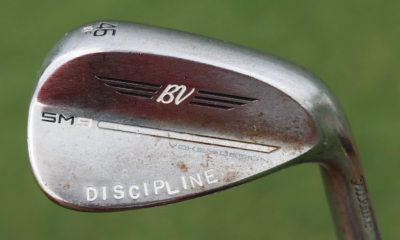



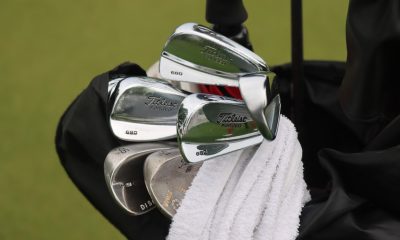

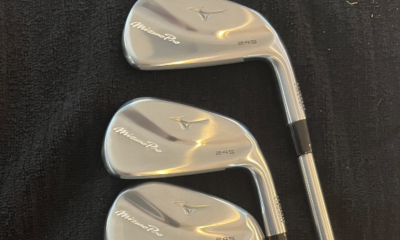















GolfCodeWeekly.com
Dec 8, 2017 at 1:25 pm
Yup the increases in the last 10 to 15 years are almost nil, i really do not get the problem, golf is fine, the ball is fine
HDTVMAN
Dec 8, 2017 at 11:49 am
When I play, the ball doesn’t go both far enough & straight enough! I’d also like to see a chip which incorporates my watch to find the ball when it goes anywhere but the fairway, which it tends to do!
Rich
Dec 8, 2017 at 11:04 am
Let the Ball fly.. I like distance and to see it fly far is exciting.. The course design should be made narrower deeper ruff more trees and sandtraps and more water . Make it more of a gambler course.I don’t like these -21 under scores .What ever happened to these under -10 course score total for the event? That’s why most people love the OPEN (US,British) because they are low scoring and a test of the skill of a player to play the course where does the risk worth the reward ! The tougher the better with some RISK/REWARD when ever available . I like to see the distance but also I want to see accuracy with the yardage.
Mark
Dec 8, 2017 at 8:59 am
The most interesting part of this to me is the distance gains prior to the introduction of the Pro V1. Looking at the chart it appears there is about a 20 yard gain from 93-00. There is another increase after the introduction of the Pro V1. To me this speaks to the complexity of the distance discussion. It can’t be reduced to only the ball. There are a lot of other factors involved.
Think about how much more advanced we are in all the different areas like driver tech, shafts, athletics and power generation, biomechanics, launch conditions, etc. Sure rolling the ball back could reduce median distance, but it’s far from the only factor.
RJM
Dec 7, 2017 at 9:23 pm
They have also talked about lowering the speeds in auto racing (granted, for primarily safety reasons) but how many fans would the sport lose, say, for the Indy 500, if the top speeds were limited to 180 or 200. People go to golf tournaments to watch PGA players hit the snot out of a golf ball. Knowing that DJ, Jason, or Rickie is somehow going to be “limited” off the tee or from the fairway takes a boatload of interest out of the game.
jeff
Dec 7, 2017 at 8:30 pm
#Whocares?
The longest hitters aren’t the only ones winning…
Sounds like a bunch of old codgers irritated their old antiquated records could one day be broken, and the golf channel stirring up something to talk about during the off months. Get over it. The game SHOULD be made easier, not harder, want the game to stick around a while longer and grow? Although data shows its hardly been made easier…. The game needs to progress, I understand keeping the integrity of the game, but there is a fine line of overdoing that to the point of people just saying “forget it, golf is too hard, too expensive, and way to much trouble to deal with, i just want to have fun with my buddies”
The tour players are better athletes now, the equipment is better, the ball is better, the courses are longer, firmer, and harder faster greens. Swings technique is better, availability to data and what ACTUALLY makes the ball go further or roll longer is easier to get and more readily available. It all adds up to hitting the ball further. Again, why is this a bad thing? To say they used to be hitting 3-4 irons and now wedges? Thats not a diff of 33 yards, its a diff of 100 yards. 33 yards is a 1-2 clubs max. Not to mention todays “5” iron is actually a 3 or 4 iron loft of old… its like the 30 handicapper saying he hit is 8iron 180 yards, well maybe? But more then likely its actually a juiced up 5-6 iron… but who cares? Ain’t no tour pro hitting a wedge in from 215 yards when he used to have to use a 3 wood from 250 because of a ball.
I sure hope the people complaining about the ball going to far and the game becoming too easy, are the same people still riding a horse to work, and going to the haberdashery to get a new button for their will jacket they made themselves… They better not be using Amazon, or Nordstrom.com to buy their suits…. You all better not be using any form of technology to make things easier and better.
Get over it, it doesn’t matter, the game is hard enough. Every sport progresses, the athletes become stronger, faster, smarter. Its called evolution, and with out it, the game dies.
Carl
Dec 7, 2017 at 8:03 pm
It seems like many people are opposed to the ball going too far because it benefits the longer hitters. But restricting the ball isn’t going to take that advantage away. If anything, they will still be hitting mid-long irons where shorter players will be hitting hybrids or woods.
To me, the underlying problem for many people calling for ball rollbacks is that they don’t see length as equivalent skill-wise to a great short game or solid putting. I’m not sure why though because the tolerances for mis-hits and clubface to club-path are smaller when you are swinging at higher speeds. There is inherently skill involved to hit it long AND straight, just as there is skill involved in bunker shots or putting.
henry
Dec 9, 2017 at 11:55 pm
this is spot on. should Rickie or Jordan be penalized bc they putt too well? Distance is a skill. Let the ones who can hit it far keep it that way. And the funny thing is, DJs skill would be even more celebrated bc hed be hitting 7 irons while other guys are hitting 5 woods.
Terry Medlar
Dec 7, 2017 at 7:40 pm
I’m not really concerned about the distance the pros are hitting, but if you want to make a change, instead of changing/restricting the ball, why not just tell the pros they can’t use their drivers?
Jon
Dec 7, 2017 at 3:29 pm
Much ado about nothing.
Prime21
Dec 7, 2017 at 3:28 pm
Cigarettes & Alcohol have killed people for a long time, but they still exist. $ is the answer you are looking for, plain & simple.
Antoine Steeghs
Dec 7, 2017 at 2:56 pm
I think youcanlook at the masters. What clubs are used to the green? Are the using 4 irons 40 years ago and now 8 irons?
chinchbugs
Dec 7, 2017 at 2:40 pm
Can you make a shoe stink?
Genuine question…
Uhit
Dec 7, 2017 at 2:34 pm
…and you have to remember, that driving distance is in this case carry and roll.
Latter is strongly correlated to the course conditions and setup – fast and firm fairways.
The recorded carry distances show no increase in distance since more than a decade.
CB
Dec 7, 2017 at 1:14 pm
It’s not that the ball goes too far – it goes too straight. Because they have been designed so well aerodynamically, they tend to not bend as much as the old Balata and wound type balls – which is what Johnny Miller has been saying, as opposed to just calling out the problem of the ball flying too far. With forgiving heads and forgiving balls – the modern players are getting away with a lot of mis-hits that the old ball would not do as well, that you had to be a much better ball striker back then. But this current ball technology is part and parcel of all this tech of heads, shafts and balls, and to talk about rolling it back now, after Eldrick made all his money and success during his career from 2000 on – with the very balls that he wants repealed – is a joke.
Hunter Brown
Dec 7, 2017 at 1:38 pm
Great point here and I agree with you to a point however if it were a problem I think we would see scoring average dramatically drop. If you look at swimming when the “shark suit” was introduced 49 world records were broken in 18 months. This is a dramatic drop and why they are now banned. We have not yet seen that kind of drop in scoring avg or records to suggest a ban is needed in my opinion
Andrew Cooper
Dec 7, 2017 at 2:15 pm
I agree 100%, how much straighter the new equipment goes is every bit as important. This is rarely spoken about. Courses have been lengthened proportionately with the new equipment, but have they been tightened up proportionately? I would imagine with measuring technology we could get a fairly good number on how much straighter the ball flies now. And let’s say we find it’s around 10% straighter (to pick a number) then bring in tour fairways by a similar amount.
Barry Martin
Dec 7, 2017 at 12:52 pm
Yes, we are about 15 years too late, but there were guys – like Nicklaus, Geoff Shackelford, etc. – who were calling it out back then. But there were a chorus of people, led by Uncle Wally at Titleist who said “Nothing to see here kids, everything’s fine, stop whining.”
https://en.wikipedia.org/wiki/Boiling_frog
Hunter Brown
Dec 7, 2017 at 1:41 pm
You are definitely right I remember Nicklaus talking about this a long time ago and that was kind of my point that it has always been a topic of conversation and why the USGA puts limits on how much it can improve. If we really do want to take away distance on the PGA Tour I think there is a lot easier and more simple way to do it. Just take away the tee. It would force players to use higher lofted “drivers” and would take away the advantage of hitting up on it. Now the unfortunate part about most of these solutions is that it will actually give the longer hitters even more of an advantage
Greg V
Dec 7, 2017 at 12:09 pm
Hunter, you stated that there has never been a ball roll-back, but you are mistaken.
For 1931, the USGA reduced the maximum weight of the ball from 1.62 ounces to 1.55 ounces. The players didn’t like it, as the ball didn’t go as far, and it was more affected by wind. They called it the ‘floater.”
It might be time to look at a reduction in the weight of the ball again, as today’s ball and club technology afford much more control in the wind. If the USGA could roll back the ball in 1931, they can certainly do it again soon to keep course lengths for elite golfers from approaching 8,000 yards.
Hunter Brown
Dec 7, 2017 at 1:35 pm
Thanks Greg I was unaware of this for sure so I appreciate you pointing it out. However it seems as though it only lasted a year so I would still contend the ball won out. Also what are your hindrances to 8,000 yard courses for pros? Also I have seen plenty of “shorter” courses hold the test of the pros. See Oakmont, Merion, Riviera, Shinnecock, etc. All of those cut lines in US Opens were significantly over par.
Andrew Cooper
Dec 7, 2017 at 11:55 am
Good work Hunter. The stats show that the limits on balls and clubs have worked since the early 2000s, so it’s strange to be having this debate now. An unspectacular 3.5 paces forward over the last 15 years-not what the industry would want the golfing public to know maybe, but there it is. So if the rules are working why change?
dat
Dec 7, 2017 at 11:44 am
I think it goes too far, and nothing can be done to stop it. If in 15 years the ball goes 15 yards further, that will continue to make the game less exciting to watch. Driver, wedge into every hole is just boring.
Drew Boggs
Dec 7, 2017 at 11:26 am
You can make great short par 4s like everyone wants to see and just make them absolutely brutal. Risk/Reward holes get the most attention out of any course or PGA Tour venue. Example, #10 at Riviera. Arguably the greatest short par 4 on tour, and everyone watches it. If you roll back the ball, you are hurting the game of golf. Juniors will not be as involved, and everyone wants and chases the 300+ yard drives. It’s our game today and what it will continue to be.
Bob Jacobs
Dec 7, 2017 at 11:05 am
I think we need 10 more articles on ball go too far!!